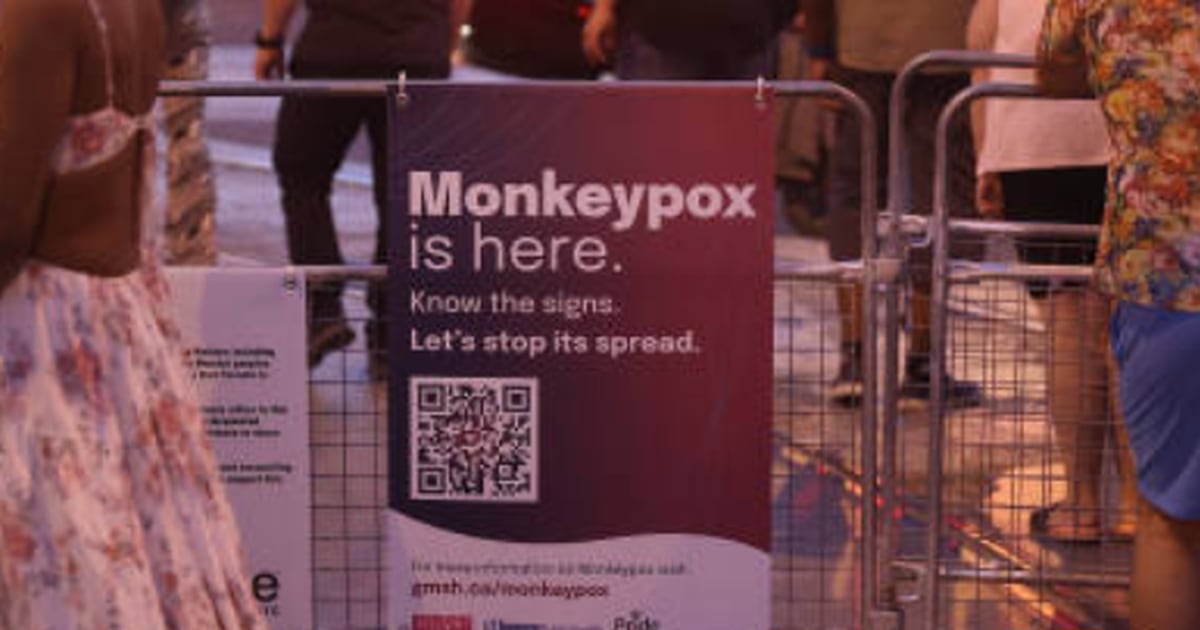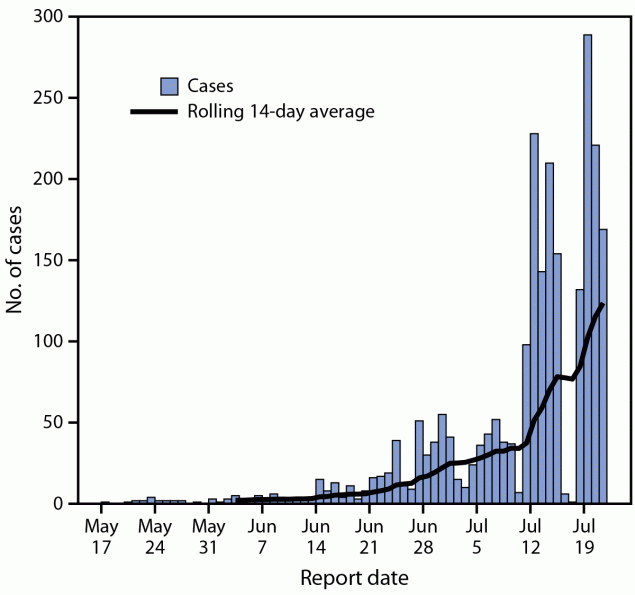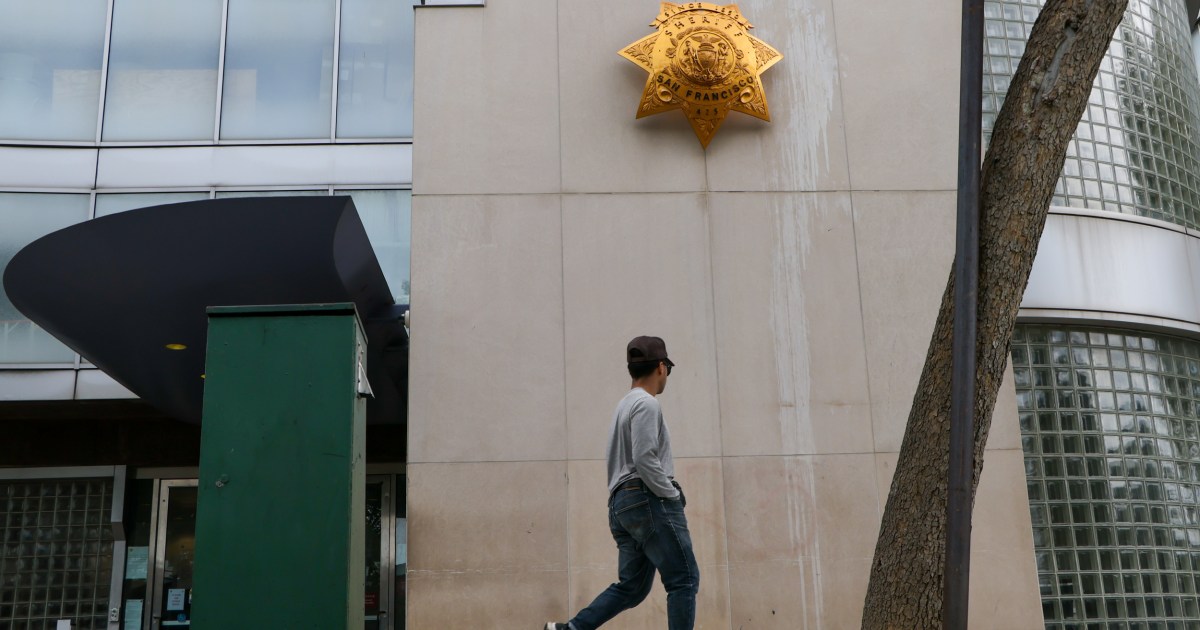...continued...
Top
Acknowledgments
Monkeypox response teams from state and local health departments in the following jurisdictions: Arizona, Arkansas, Colorado, Connecticut, Delaware, District of Columbia, Georgia, Hawaii, Idaho, Illinois, Indiana, Iowa, Kansas, Kentucky, Louisiana, Maryland, Massachusetts, Michigan, Minnesota, Missouri, Nebraska, Nevada, New Jersey, New Mexico, New York, North Carolina, North Dakota, Ohio, Oklahoma, Oregon, Pennsylvania, Puerto Rico, Rhode Island, South Carolina, Tennessee, Texas, Wisconsin, Utah, Virginia, Washington, and West Virginia.
CDC Multinational Monkeypox Response Team
Isabel Griffin, CDC; Mohammed Khan, CDC; Yasmin Ogale, CDC; Emily Sims, CDC; R. Ryan Lash, CDC; Jeanette J. Rainey, CDC; Kelly Charniga, CDC; Michelle A. Waltenburg, CDC; Patrick Dawson, CDC; Laura A.S. Quilter, CDC; Julie Rushmore, CDC; Mark R. Stenger, CDC; Rachel E. Kachur, CDC; Florence Whitehill, CDC; Kelly A. Jackson, CDC; Jim Collins, Michigan Department of Health and Human Services; Kimberly Signs, Michigan Department of Health and Human Services; Gillian Richardson, Louisiana Department of Health; Julie Hand, Louisiana Department of Health; Emily Spence-Davizon, Colorado Department of Public Health and Environment; Brandi Steidley, Colorado Department of Public Health and Environment; Matthew Osborne, Massachusetts Department of Public Health; Susan Soliva, Massachusetts Department of Public Health Joanna Shaw-KaiKai Nashville Metro Public Health Department; Sabrina Cook, Nashville Metro Public Health Department; Leslie Ayuk-Takor, DC Department of Health; Christina Willut, DC Department of Health; Alexandria Snively, Indiana Department of Health; Nicholas Lehnertz, Minnesota Department of Health; Daniela N. Quilliam, Rhode Island Department of Health; Miranda Durham, New Mexico Department of Health; Iris R. Cardona-Gerena, Puerto Rico Department of Health; Linda J. Bell, South Carolina Department of Health; Environmental Control; Marina Kuljanin, Maricopa County Department of Health; Suzanne Gibbons-Burgener, Wisconsin Department of Health Services; Ryan Westergaard, Wisconsin Department of Health Services; Lynn E. Sosa, Connecticut Department of Public Health; Monica Beddo, Missouri Department of Health and Senior Services; Matthew Donahue, Nebraska Department of Health and Human Services; Samir Koirala, Nebraska Department of Health and Human Services; Courtney Dewart, Ohio Department of Health, Career Epidemiology Field Officer, CDC; Jade Murray-Thompson, Utah Department of Health and Human Services; Lilian Peake, Virginia Department of Health; Michelle L. Holshue, Washington Department of Health; Atul Kothari, Arkansas Department of Health; Jamie Ahlers, Delaware Department of Health and Social Services; Lauren Usagawa, Hawaii Department of Health; Megan Cahill, Idaho Division of Public Health; Erin Ricketts, North Carolina Department of Health and Human Services; Mike Mannell, Oklahoma State Department of Health; Farah S. Ahmed, Kansas Department of Health and Environment; Bethany Hodge, Kentucky Department for Public Health; Brenton Nesemeier, North Dakota Department of Health; Katherine Guinther, West Virginia Bureau for Public Health; Madhu Anand, New York State Department of Health; Jennifer L. White, New York State Department of Health; Joel A. Ackelsberg, New York City Department of Health and Mental Hygiene; Ellen H. Lee, New York City Department of Health and Mental Hygiene; Devin Raman, Southern Nevada Health District; Carmen Brown, Pennsylvania Department of Health; Nicole Burton, New York City Department of Health and Mental Hygiene; Sarakay Johnson, Metro Public Health Department–Nashville.
Top
Corresponding author: David Philpott,
DPhilpott@cdc.gov.
Top 1Epidemic Intelligence Service; 2CDC Monkeypox Response; 3New York City Department of Health and Mental Hygiene, New York, New York; 4Chicago Department of Health, Chicago, Illinois; 5Georgia Department of Health; 6Philadelphia Department of Public Health, Philadelphia, Pennsylvania; 7New York State Department of Health; 8Oregon Department of Health; 9Texas Department of State Health Services; 10Maryland Department of Health; 11Michigan Department of Health and Human Services; 12Louisiana Department of Health; 13Colorado Department of Public Health and Environment; 14Massachusetts Department of Public Health; 15Tennessee Department of Health; 16DC Department of Health; 17Illinois Department of Public Health; 18Minnesota Department of Health; 19Rhode Island Department of Health; 20Indiana State Department of Health; 21Southern Nevada Health District, Las Vegas, Nevada; 22New Mexico Department of Health; 23Puerto Rico Department of Health; 24South Carolina Department of Health and Environmental Control; 25Laboratory Leadership Service, CDC; 26Arizona Department of Health Services; 27Wisconsin Department of Health Services; 28Ohio Department of Health; 29Connecticut Department of Public Health; 30Career Epidemiology Field Officer Training Program, CDC 31Missouri Department of Health and Senior Services; 31Salt Lake County Health Department, Salt Lake City, Utah; 32Pennsylvania Department of Health.
Top
All authors have completed and submitted the International Committee of Medical Journal Editors form for disclosure of potential conflicts of interest. Mary-Margaret A. Fill reports Council of State and Territorial Epidemiologists (CSTE) travel support to attend annual CSTE conference and uncompensated membership on the University of Tennessee’s One Health Initiative board. No other potential conflicts of interest were disclosed.
Top
* These authors contributed equally to this report.
†
Monkeypox in the U.S.
§
Monkeypox in the U.S.
¶ A probable case was defined as illness for which there was no suspicion of other recent orthopoxvirus exposure and one of the following: 1) detection of orthopoxvirus DNA by polymerase chain reaction testing of a clinical specimen, 2) evidence of orthopoxvirus antigen using immunohistochemical staining or visualization by electron microscopy, or 3) demonstration of detectable levels of antiorthopoxvirus immunoglobulin M antibody during the 4–56 days after rash onset. A confirmed case was defined as 1) the presence of
Monkeypox virus DNA by polymerase chain reaction testing or Next-Generation sequencing of a clinical specimen or 2) isolation of
Monkeypox virus in culture from a clinical specimen.
** 45 C.F.R. part 46, 21 C.F.R. part 56; 42 U.S.C. Sect. 241(d); 5 U.S.C. Sect. 552a; 44 U.S.C. Sect. 3501 et seq.
†† Prodrome defined as at least one of the following: fever, myalgias, malaise, headaches, lymphadenopathy, or chills occurring as first symptom, not accompanied by a rash.
§§
Gay and Bisexual Men's Health | CDC
¶¶
https://www.hhs.gov/about/news/2022/...companies.html
***
https://www.cdc.gov/poxvirus/monkeyp...ccination.html
Top
References
- Diamond D. Monkeypox is a public health emergency. The Washington Post. August 4, 2022. https://www.washingtonpost.com/healt...states-becerra
- Minhaj FS, Ogale YP, Whitehill F, et al. ; Monkeypox Response Team 2022. Monkeypox outbreak—nine states, May 2022. MMWR Morb Mortal Wkly Rep 2022;71:764–9. https://doi.org/10.15585/mmwr.mm7123e1 PMID:35679181
- Thornhill JP, Barkati S, Walmsley S, et al. ; SHARE-net Clinical Group. Monkeypox virus infection in humans across 16 countries—April–June 2022. N Engl J Med 2022. Epub July 21, 2022. https://doi.org/10.1056/NEJMoa2207323 PMID:35866746
- US Census Bureau. Supplementary tables on race and Hispanic origin: 2020 census redistricting data. Washington, DC: US Department of Commerce, US Census Bureau; 2021. https://www2.census.gov/programs-sur...y-table-04.pdf
- McCollum AM, Damon IK. Human monkeypox. Clin Infect Dis 2014;58:260–7. https://doi.org/10.1093/cid/cit703 PMID:24158414
- Tarín-Vicente EJ, Agud-Dios M, Alemany A, et al. Clinical presentation and virological assessment of confirmed human monkeypox virus cases in Spain : a prospective cohort study. Rochester, NY: SSRN 2022. [Preprint posted July 18, 2022]. Clinical Presentation and Virological Assessment of Confirmed Human Monkeypox Virus Cases in Spain : A Prospective Cohort Study
- Patel A, Bilinska J, Tam JCH, et al. Clinical features and novel presentations of human monkeypox in a central London centre during the 2022 outbreak: descriptive case series. BMJ 2022;378:e072410. https://doi.org/10.1136/bmj-2022-072410 PMID:35902115
- O’Shea J, Filardo TD, Morris SB, Weiser J, Petersen B, Brooks JT. Interim guidance for prevention and treatment of monkeypox in persons with HIV infection—United States, August 2022. MMWR Morb Mortal Wkly Rep 2022;71. https://www.cdc.gov/mmwr/volumes/71/...cid=mm7132e4_w
Top
 FIGURE. Monkeypox cases, by report date* — United States, May 17–July 22, 2022
FIGURE. Monkeypox cases, by report date* — United States, May 17–July 22, 2022
* Includes either the positive laboratory test report date, CDC call center reporting date, or date of case data entry into CDC’s emergency response common operating platform.
 www.timebomb2000.com
www.timebomb2000.com


:quality(70)/cloudfront-us-east-1.images.arcpublishing.com/cmg/B3OZC6YZLJD4FBI4OECTZGJU6Y.jpeg)








